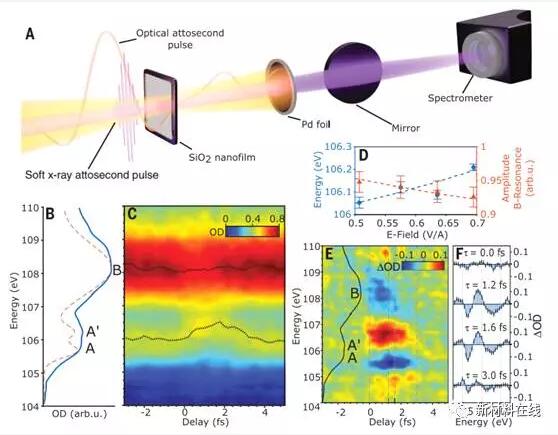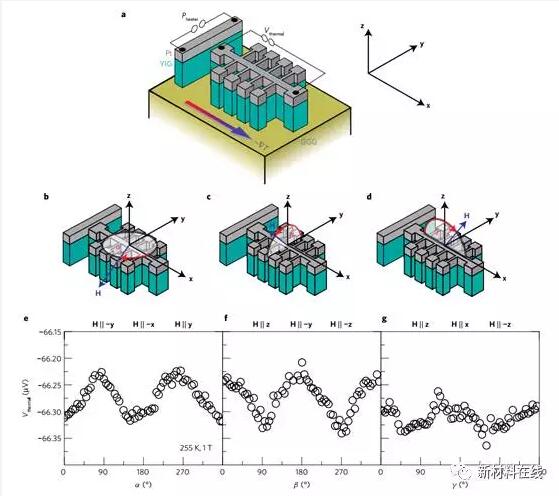Abstract 1. The dynamic response of soft x-ray excitonics in solids is at the heart of modern condensed phase physics, materials science, and photonics. However, research and control to date has been limited to the fact that photon energy is lower than the basic band gap...
1. Soft X -ray excitonics
The dynamic response of excitons in solids is at the heart of modern condensed phase physics, materials science, and photonics. However, research and control to date have been limited to situations where photon energy is below the basic band gap. Moulet et al. reported the use of attosecond soft X-rays and attosecond pulses to study the kinetics of nuclear-exciton at the L2,3 edge of Si in silicon dioxide (SiO2). This atomic X-ray near-edge absorption spectroscopy (AXANES) technique can directly detect the quasi-particle characteristics of excitons, track their sub-femtosecond relaxation, measure exciton polarizability, and observe dark-exciton states. The ability to directly measure and control nuclear-excitons in solids lays the foundation for X-ray exciton. (Science DOI: 10.1126/science.aan4737)
2. Biological fabrication of cellulose fibers with tailored properties
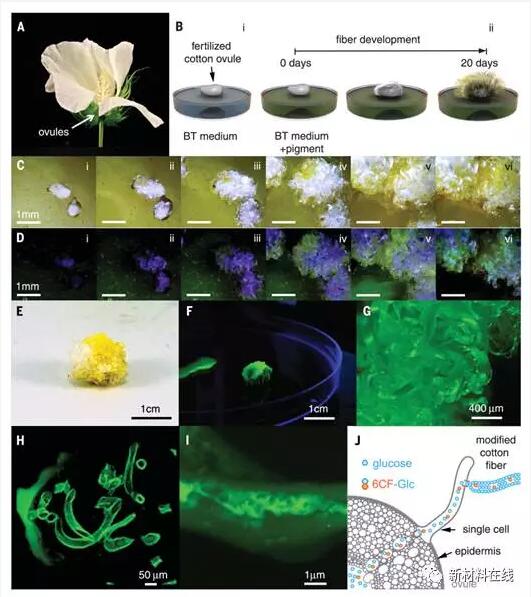
For wearable smart textiles, cotton is a promising base. Current methods that rely on fiber coatings experience loss of function during wear. Natalio et al. proposed a method that allows foreign molecules to be incorporated into cotton fibers in a bioincorporated form to adjust the function of the material. In vitro model culture of Gossypium hirsutum with 6-carboxyfluorescein-glucose and indole-1,4,7,10-tetraazacyclododecane-1,4,7,10-tetraacetic acid- Glucose is cultured together with a portion of glucose that acts as a carrier capable of propagating from the tubular junction to the outermost cell layer of the ovule epidermis and is suitable for incorporation into cellulosic fibers. This produces fibers with unnatural properties, such as fluorescent or magnetic properties. Combining biological systems with appropriate molecular design provides a variety of possibilities for developing functional composites and achieving material planting concepts. (Science DOI: 10.1126/science.aaf7447)
3. Highly efficient electrocaloric cooling with electrostatic actuation
Solid-state refrigeration has potential advantages over traditional cooling systems, but few devices can provide high cooling power with a high coefficient of refrigeration (COP). Ma et al. developed a cooling device with high intrinsic thermodynamic efficiency using a flexible electrothermal (EC) polymer membrane and an electrostatic actuation mechanism. The reversible electrostatic force reduces parasitic power consumption and enables efficient heat transfer through good thermal contact with the heat source or heat sink. The EC device produces 2.8 W/g and a COP of 13. The new cooling unit is more efficient and compact than existing surface mount solid state cooling technology, opening the way for this technology in a variety of practical applications. (Science DOI: 10.1126/science.aan5980)
4. Fabrication of fillable microparticles and other complex 3D microstructures (Fabrication of fillable microparticles and other complex 3D microstructures)

Today, three-dimensional (3D) microstructures produced by micromachining and additive manufacturing have proven their value in many fields, from biomedicine to microelectronics. However, the techniques used to create these devices each have their own characteristic advantages and limitations in terms of resolution, material compatibility, and geometric constraints that determine the types of microstructures that can be formed. McHugh et al. describe a micromachining process called polymer layer assembly of StampEd (SEAL) and produces injectable pulsatile drug delivery microparticles, pH sensors, and 3D microfluidic devices that cannot be produced using conventional 3D printing. SEAL allows the creation of microstructures with complex geometries at high resolution, producing fully enclosed lumens containing solids or liquids, and possibly using any thermoplastic material that does not contain processing additives. (Science DOI: 10.1126/science.aan5830)
5. Electrotunable nanoplasmonic liquid mirror (Electrotunable nanoplasmonic liquid mirror)
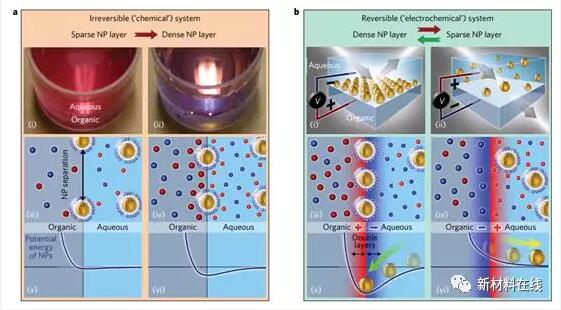
The design and development of fully tunable metamaterials for applications ranging from new sensors to superlenses has been driven by powerful driving forces. While some progress has been made, real-time tuning and modulating optical performance remains a challenge. For the first time, Montelongo et al. realized a reversible electrically tunable liquid mirror based on voltage-controlled self-assembly/disassembly of 16 nm plasmonic nanoparticles at the interface of two immiscible electrolyte solutions. They demonstrated their optical properties such as reflectivity and absorption band spectral position, which can be varied in situ within ±0.5V. The observations are in good agreement with the theoretical calculations and correspond to changes in the average particle spacing. This electrochemically fully tunable nanoplasma platform can be switched from a highly reflective "mirror" to a transmissive "window" and converted back again. This research opens the way for future micro/nano-scale electrochemical cells to achieve this platform, enabling the creation of tunable plasmonic metamaterials. (Nature Materials DOI: 10.1038/NMAT4969)
6. Observation of the spin Nernst effect (Observation of the spin Nernst effect)
Observations of the spin Hall effect have led to an in-depth study of pure spin current transmission. With the spin Hall effect, both the spin Seebeck effect and the spin Peltier effect have been observed, and the picture of pure spin current transmission is almost complete. The only missing part is the spin-energy (-Ettingshausen) effect, which has so far been discussed on a theoretical basis. Meyer et al. reported observations of the spin Nernst effect. They generated a pure transverse spin current in the Pt film by applying a longitudinal temperature gradient. To read the data, the spin-dependent current in Pt is converted to a controlled change in the longitudinal and lateral thermal voltages using a spin-dependent spin-dependent shift into the adjacent yttrium iron garnet layer. This experiment shows that the spin-Nernst and spin Hall effects of Pt are comparable, but differ in sign, as evidenced by first-principles calculations. (Nature Materials DOI: 10.1038/NMAT4964)
7. Quantum tricritical points in NbFe2 (Quantum tricritical points in NbFe2)
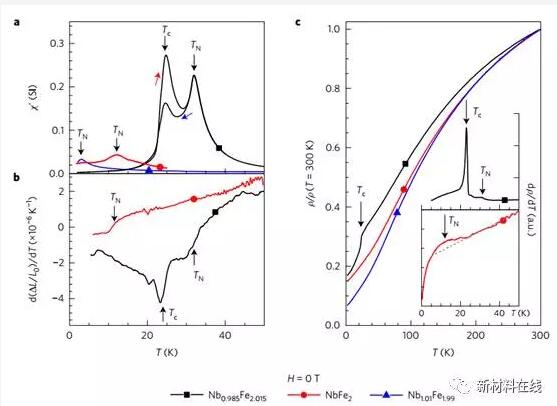
The quantum critical point (QCP) occurs when the second-order phase transition is suppressed to zero temperature. In metals, the quantum fluctuations of this QCP can produce new phases with unconventional superconductivity. Although there has been considerable research on antiferromagnetic QCP, it is much more difficult to achieve ferromagnetic (FM) QCP. In almost all metals, FM QCP is avoided by changing the first order transition or by the intermediate density wave (SDW) phase. Friedemann et al. studied the second case, NbFe2, which demonstrates that phase diagrams can be modeled using second-order parametric theory in which the putative FM QCP is buried in the SDW phase. They determined the existence of a three-weight sub-critical point (QTCP) at which uniform and finite wave vectors are sensitive and divergent. The ubiquity of this model suggests that this QTCP naturally occurs between the SDW and FM sequences and is usually found near this type of buried FM QCP. The results of this study make NbFe2 the first example of QTCP, which has been proposed as a key concept for a range of narrow-band metals, including the excellent heavy fermion compound YbRh2Si2. (Nature Physics DOI: 10.1038/NPHYS4242)
8. Zero-power infrared digitizers based on plasmonically enhanced micromechanical photoswitches
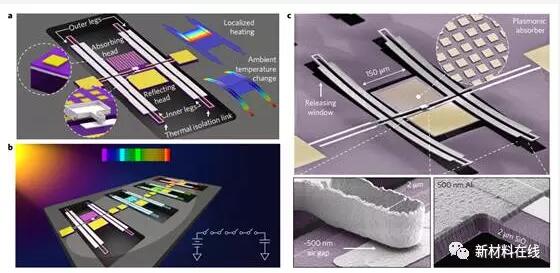
The most advanced sensors today use active electronics to detect and identify light, sound, vibration and other signals. But even if no relevant data is detected, these active devices consume power continuously, which limits their useful life and makes the cost of deploying and maintaining an unattended sensor network very high. Qian et al. proposed a device concept that can fundamentally break this paradigm, that is, the sensor remains dormant, close to zero power consumption, until it is awakened by specific physical signs associated with the event of interest. They also showcased an infrared digitizing sensor consisting of a plasma-enhanced micro-mechanical optical switch (PMP) that selectively collects incident electromagnetic energy in the spectral band of interest in the design specification, thus eliminating the need for any additional In the case of a power source, the electromagnetic energy is utilized to mechanically create a conductive path between the two electrical contacts. When such a zero-power digitized sensor prototype device is exposed to a specific narrow spectral band (in the mid-infrared, about 900 nm bandwidth) of infrared radiation with an intensity superpower threshold (about 500 nW), a digital output bit can be generated (ie, when exposed to In the case of infrared light, a large and sharp off-on state transition is produced with a switching conductivity greater than 1012 and a subthreshold slope greater than 9 dec nW-1). This is not possible with any other existing optical switching technology. (Nature Nanotechnology DOI: 10.1038/NNANO.2017.147)
Emergency Exit Sign Light
Naips carries a large selection of Emergency Exit Sign Light for your option. Patterns can be customized and replace.
wall mounted, hanging or Recessed are available. No matter it's to light the way to fire safety or to help your workforce identify the quickest exit, you will find the right solution for every environment.
Emergency Exit Light,Led Exit Signs,Neon Exit Sign,Emergency Exit Sign Light
Foshan Nai An Lighting Electric Co.,ltd , https://www.articalight.com
